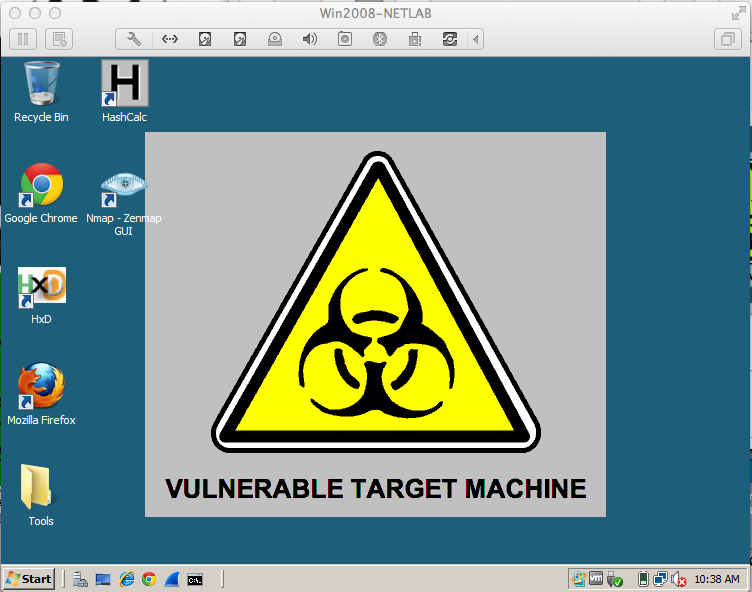
https://my.vmware.com/web/vmware/free#desktop_end_user_computing/vmware_player/7_0
In the VMs-S214 window, right-click the empty space and click New, Folder. Name the folder "YOUR NAME VMs" replacing YOUR NAME with your own name.
http://games.samsclass.info/secret/download-vms.htm
You need a username and password to view that page. The username and password are written on the blackboard in the hacking lab, and you can get them from your instructor.
The two files you need are:
If you are using a Mac, get The Unarchiver
DO NOT PUT VIRTUAL MACHINES ON THE C: DRIVE IN S214. They fill the drive and make the machine unusable, and will be deleted.
Right-click the Kali-Linux-...7z file, click 7-Zip, and click "Extract Files...". In the "Extract to:" box, enter the path to the folder you prepared, such as "G:\YOURNAME\Kali". Click OK.
DO NOT PUT VIRTUAL MACHINES ON THE C: DRIVES IN S214! They fill the drive and make the machines stop working. Virtual machines left on the desktop, Documents folder, or other C: drive locations may be deleted at any time, as needed to keep the machines working.
In the VMware Player window, click the green "Play virtual machine" button.
VMware Player will pop up several dialog boxes, asking whether this machine was moved or copied, telling you details about the processor, etc. Just accept the default choice for all those boxes.
To log in, you need to send a Ctrl+Alt+Delete to the virtual machine. On a Windows host, you can usually press Ctrl+Alt+Insert to do that. If that doesn't work, hunt through the VMware menus to send a Ctrl+Alt+Delete.
Log in as Administrator with a password of P@ssw0rd
When the server starts, it opens some windows by default. Close all windows.
You should see the Windows Server 2008 desktop as shown below:

In the "Virtual Machine Settings" box, on the left side, click "Network Adapter".
On the right side, click "Bridged: Connect directly to the physical network", as shown below. Click OK.
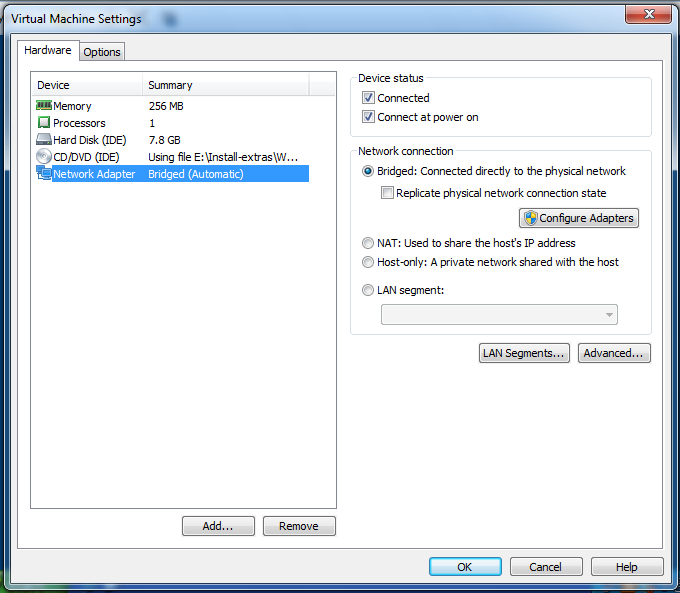
http://google.comIf you cannot open Google, which happens very often, try the troubleshooting steps listed below.
Troubleshooting a VMware Network Connection
- RESTART: Restart the virtual machine
- USE DHCP: In the virtual machine, click Start. In the Search box, type CONTROL NETCONNECTIONS and press Enter. Right-click "Local Area Connection" and click Properties. Double-click "Internet Protocol Version 4 (TCP/IPv4)" and make sure both the "Obtain an IP address automatically" and "Obtain DNS server address automatically" buttons are selected. Click OK. Click OK.
- REPAIR THE CONNECTION: In the virtual machine, click Start, Control Panel, Network Connections. Right-click "Local Area Connection" and click Repair.
- VMWARE BRIDGE PROTOCOL: In the Host machine, click Start and type "NETWORK CONNECTIONS" into the Search box. In the results, click "View network connections". Right-click "Local Area Connection" and click Properties. Make sure the "VMware Bridge Protocol" item is checked. Click OK.
- MAKE A NEW VIRTUAL MACHINE: When all these actions fail, which is very common, you need to discard the virtual machine and extract a fresh one from the original .7z file.
In the Command Prompt screen, type in IPCONFIG and press the Enter key.
Your IP address apears, as shown below.
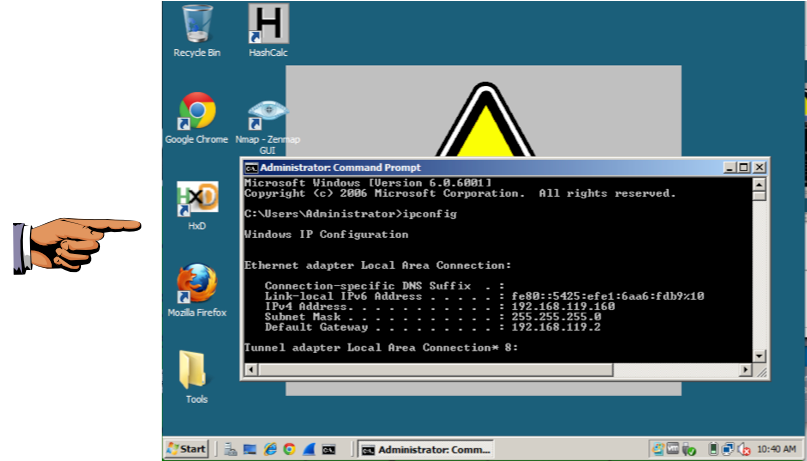
You have now completed the first part of Project 1. To prove it, you need to capture an image of the screen and email it to me.
Note the hand symbol on the image above: that indicates screen images that you must capture and turn in.
Click the taskbar at the bottom of your host Windows 10 desktop, to make the host machine listen to the keyboard, instead of the virtual machine.
Press the PrintScrn key in the upper-right portion of the keyboard. That will copy the whole desktop to the clipboard.
YOU MUST SUBMIT A FULL-SCREEN IMAGE FOR FULL CREDIT!
On the host machine, not the virtual machine, click Start.
Type mspaint into the Search box and press the Enter key.
Click in the untitled - Paint window, and press Ctrl+V on the keyboard. The desktop appears in the Paint window.
In the upper left corner of the "untitled - Paint" window, click the little blue square icon (it looks like a floppy disk, something people used to use long ago--you might never have seen one).
Save the document with the filename "YOUR NAME Proj 1a", replacing "YOUR NAME" with your real name.
Troubleshooting: Number of Processors
If you see a message saying the virtual machine is configured to use four processors, adjust it with these steps:
- On the left side of the VMware Player window, click Kali once to select it.
- On the lower right side of the VMware Player window, click "Edit virtual machine settings".
- On the left side of the Virtual Machine Settings window, click Processors
- On the right side of the Virtual Machine Settings window, adjust the number to 1 and click OK
Troubleshooting: Slow Performance
If your virtual machines run very slowly, your host machine may be low on RAM.
You can adjust the RAM using the Virtual Machine Settings window, as explained in the previous Troubleshooting box.Try lowering the RAM on the VMs. Lower the Kali RAM to 1024 MB, and the Windows 2008 machine to 512 MB of RAM.
If you don't see a user named "root", click Other....
Log in to Kali with the username root and a password of toor
You should see the Kali Linux desktop as shown below:
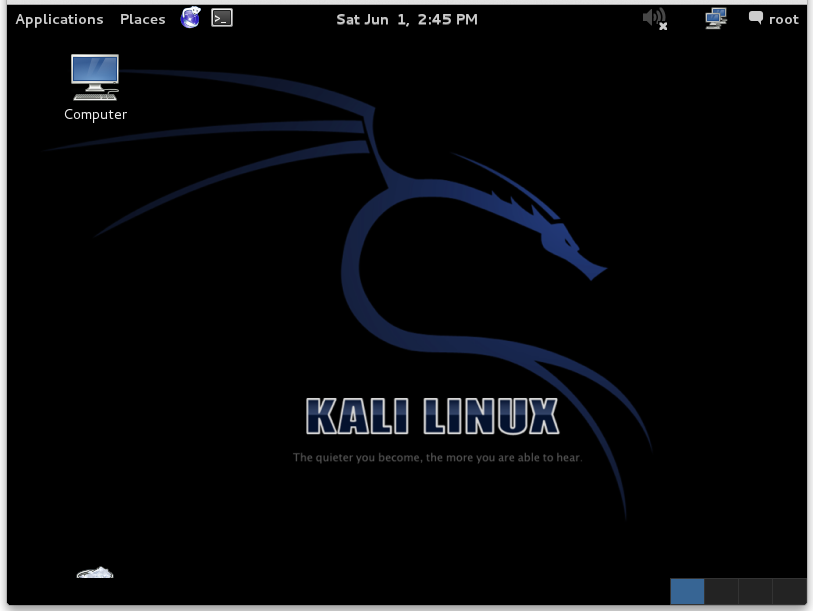
In the "Virtual Machine Settings" box, on the left side, click "Network Adapter".
On the right side, click "Bridged: Connect directly to the physical network". Click OK.
At the top left of the Kali Linux desktop, find these items:
In the Terminal window, type in this command to get a new IP address, and then press the Enter key:
dhclient -v
ifconfig
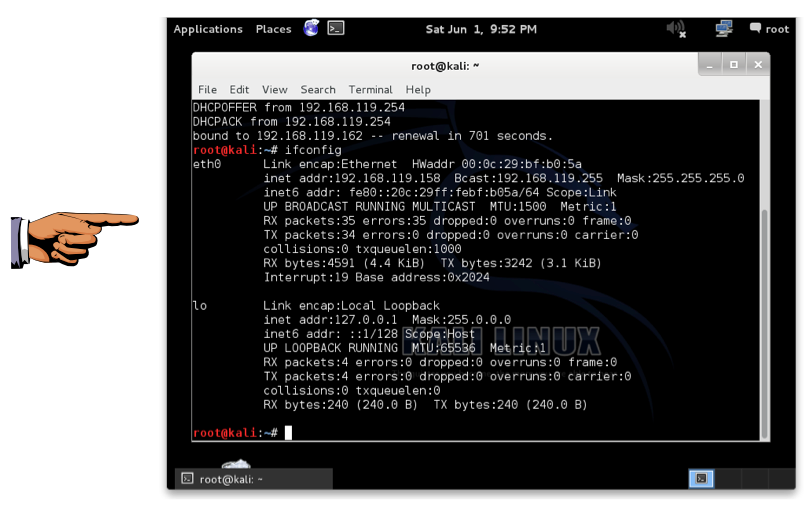
Click the taskbar at the bottom of your host Windows 10 desktop, to make the host machine listen to the keyboard, instead of the virtual machine.
Press the PrintScrn key in the upper-right portion of the keyboard. That will copy the whole desktop to the clipboard.
YOU MUST SUBMIT A FULL-SCREEN IMAGE FOR FULL CREDIT!
On the host machine, not the virtual machine, click Start.
Type mspaint into the Search box and press the Enter key.
Click in the untitled - Paint window, and press Ctrl+V on the keyboard. The desktop appears in the Paint window.
Save the document with the filename "YOUR NAME Proj 1b", replacing "YOUR NAME" with your real name.
Make sure both machines are in Bridged networking mode! The most common problem students have is incorrect networking modes. Unless otherwise specified, make sure all virtual machines you use in this class are in Bridged networking mode.
Email the images to me as an attachments to an e-mail message. Send it to: cnit.123@gmail.com with a subject line of "Proj 1 From YOUR NAME", replacing "YOUR NAME" with your real name.
Send a Cc to yourself.
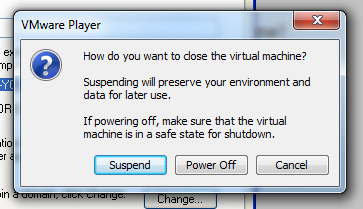
Suspend freezes your VM in its current state. This is usually the best choice.
Power Off is only for emergencies, when the guest operating system has crashed. It's the equivalent of pulling out the power plug on a real computer.
Click Suspend.
Last Modified: 2-4-17